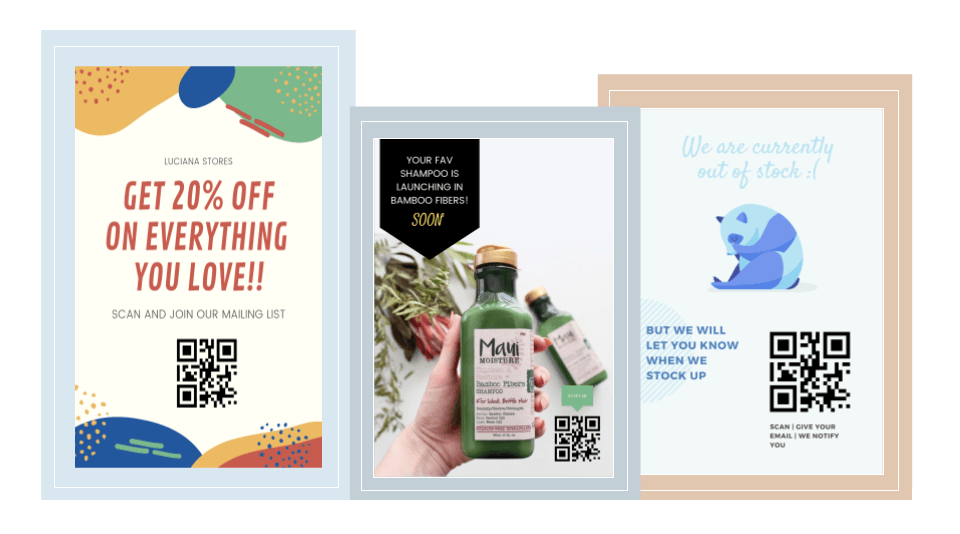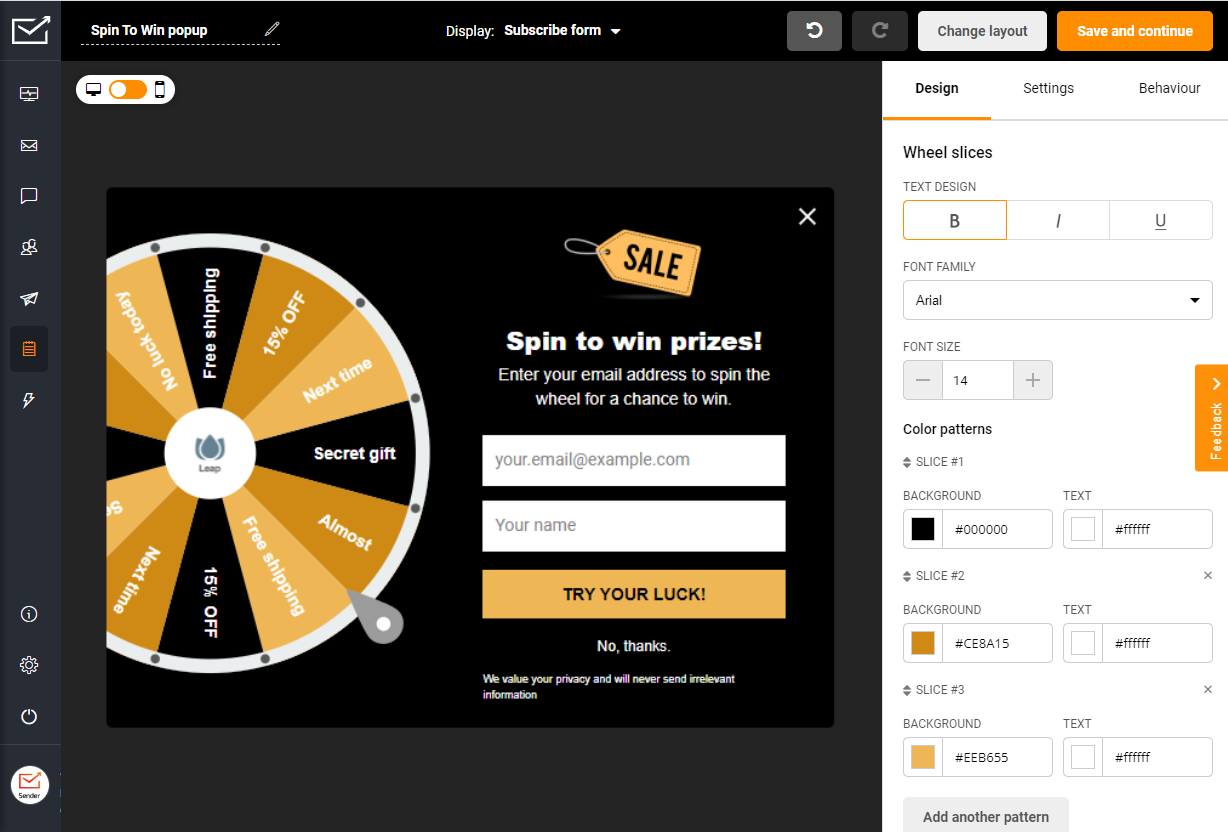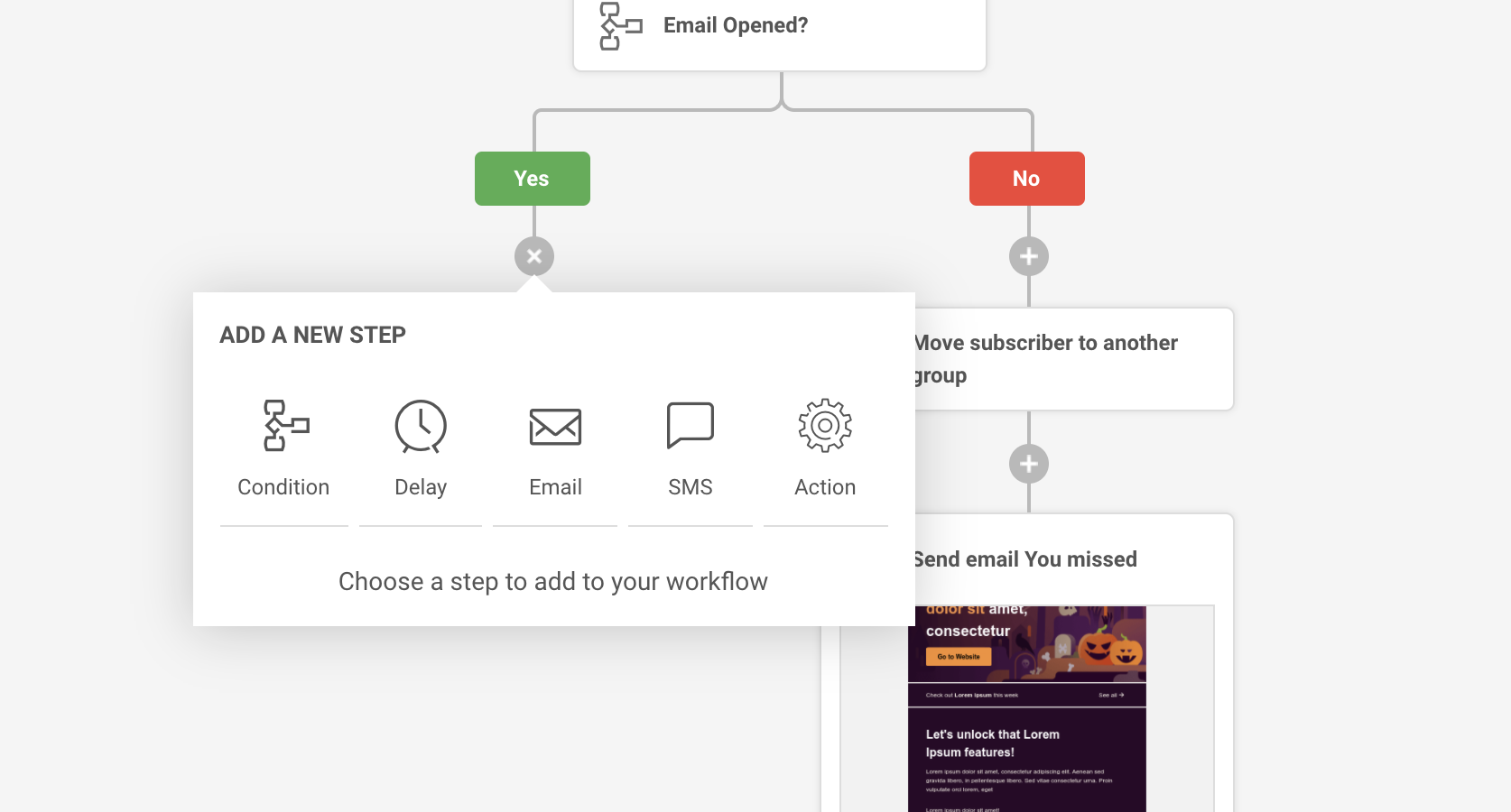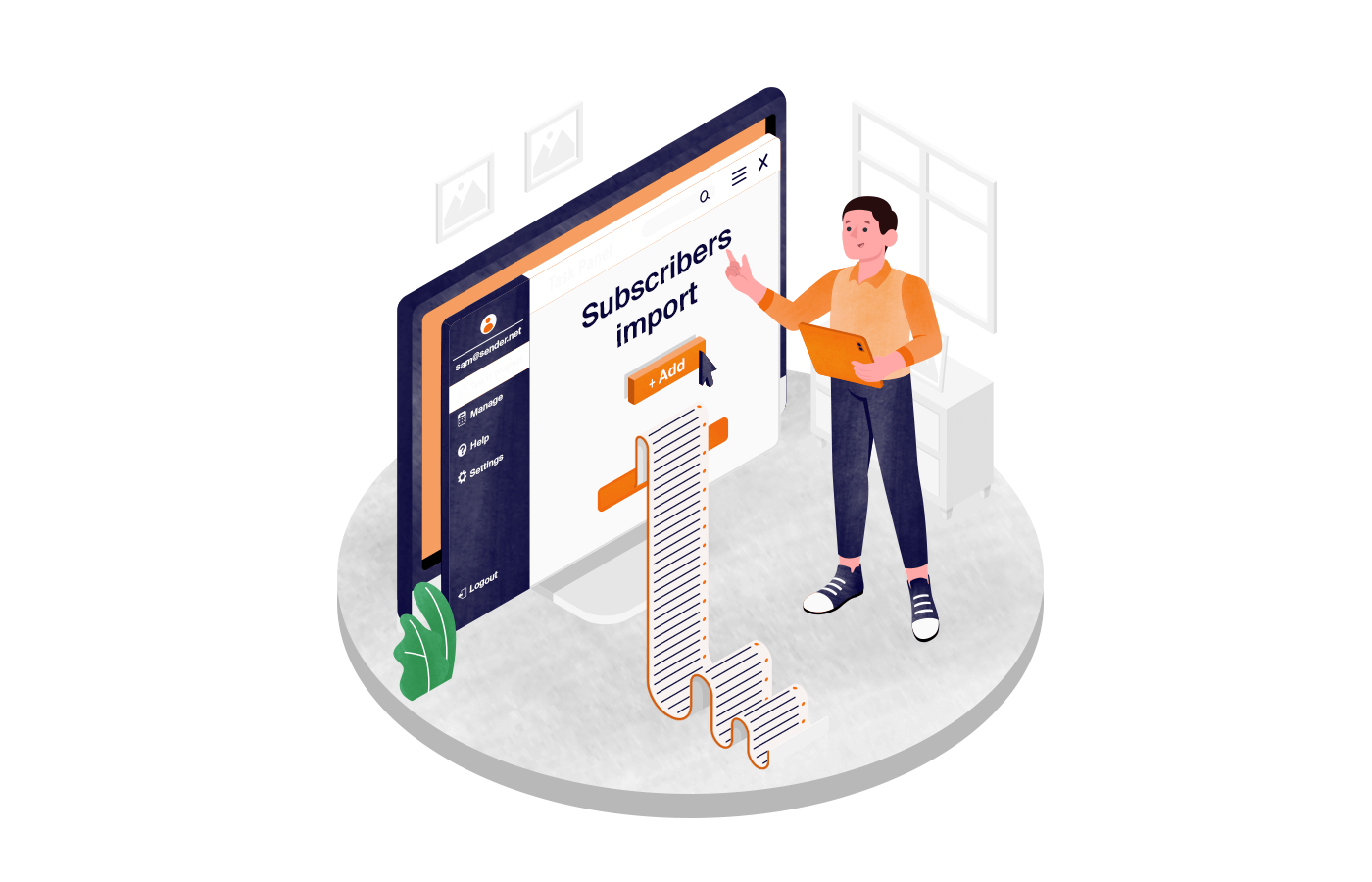Building an email list is like nurturing a garden – you need several things to make everything work. Just as plants need healthy seeds, fertile soil, and ample sunlight to thrive, your list-building strategy requires the right mix of tactics, content, and approach to grow.
Growing the list is about patience meeting strategy to create a fertile ground for long-term relationships. Today, we’ll share 14 proven strategies to grow your email list and the dos and don’ts for effective email list building.
How to Build an Email List: 14 Easy-to-Implement Tactics
If you’ve been googling – ‘How to make an email list for free?’ and want to start a newsletter, we’ve got some ideas on how to set up an email list. Learn how to start building your email list and grow your subscriber base for free by following the tips below:
Add a Signup Form on the Homepage
An email sign up form helps collect email addresses from website visitors. It “pops up” on the homepage, inviting them to sign up in exchange for an incentive: a discount, special offer, newsletter subscription, etc. Here’s an example of a website popup:

As much as everyone loves to hate popups, they are among the most effective ways to build your email list. In fact, on average, website pop ups convert 3.8% of visitors.
Quickly build your mailing list by adding the following in your popup:
- A heading and subheading that promises and details an offer that’s hard to refuse.
- A call-to-action (CTA) button that urges to act.
- An email input field where visitors can submit their addresses.
- Visual branding to put your name next to the offer.
For more inspiration check out 13 newsletter signup examples & how to create an effective form.
Utilize QR Codes
QR codes can help you capture instant attention and grow your email list when used contextually. They’re easy to create, can be placed almost anywhere, and make people curious about scanning them.
Here are some ways to use QR codes in your email marketing strategies:
- Email signatures. Include a QR code in your email signature. Every email you send becomes an opportunity for the recipient to join your email list by simply scanning the code;
- Print QR code on marketing materials. Add QR codes to your business cards, flyers, posters, brochures, packaging, you name it. When people scan the code, direct them to a landing page where they can subscribe to your email list;
- Event promotions. Use QR codes at events, workshops, or trade shows. Encourage attendees to scan the code to receive event updates, special offers, or exclusive content.
- Digital content. Add QR codes to your digital content, such as a social media post, blog post, website banner, and lead magnet. This way, users can easily add themselves to your subscriber list with a simple phone scan.
Ensure that your QR code is accompanied by a clear and compelling call-to-action (CTA), such as “Scan to Subscribe for Exclusive Updates!”. You can also offer an incentive, like a discount, freebie, or access to exclusive content, to encourage people to subscribe.

Use Popup Forms like Exit Intent and Spin-to-Win
Every website visitor is unique, and depending on your audience, you can use different variations of pop up forms, such as exit intent or spin to win, to entice them to sign up for your regular emails.
Try to build your own Spin-to-Win popup with Sender: it’s super easy yet very effective. Start capturing leads like a Pro!

A spin-to-win popup works simply. After users enter their contact details, they can spin the wheel for a chance to win a prize. This adds “gamification” to your website, making signing up for an email list fun.
Exit-intent popups appear when a visitor wants to leave your website. When they move their mouse onto another tab or intend to exit the website, they’re shown exit pop ups with a valuable offer, such as a coupon code, or exclusive product demo that requires them to fill out email opt in forms.
Here are some best practices to make the most of your popup form:
- The popup forms should appear at the right time — 15-30 seconds after website entry, when a user is about to leave, or based on the user’s behavior;
- Your forms should match your brand style;
- Ensure your popup forms are responsive and can fit any device.
To make it truly effective, you must make the CTA (call-to-action) pop. Free your imagination when designing the button and crafting the copy to catch the visitor’s eye.
But don’t forget that it should stay in line with your branding. While a bright red button with “Buy now!!!” is visible, it will steer away shocked readers.
Lacking creativity? Discover 20 newsletter popup design examples that inspire.
Create a Dedicated Sign-Up Landing Page
According to HubSpot research, increasing the number of landing pages from 10 to 15 results in a 55% increase in leads.
It makes sense since personalized landing pages let you reach a broader audience. Everyone who visits your website needs something different, so the more landing pages you create to address each person’s specific needs, the more sign-ups you’ll receive.
To create effective personalized landing pages, you should:
- Understand where your website visitors are in the customer journey;
- Target users based on their behavior, demographics, and interests;
- Determine the specific type of content you want to deliver to each target audience.
Entice Website Visitors with Valuable Content
Posting relevant and valuable content on your blogs and social media is a great idea to grow your email list. 73% of brands post valuable content on social media platforms to drive traffic and engagement.
Use organic channels to attract visitors and prospects and compel them to leave their emails. Offer something your visitors can’t resist, like a free guide or a discount, in exchange for their email.
It’s like giving a free sample at a store; if they like it, they’ll want more. For instance, “Sign up and get a 10% off coupon” on your web pages. Or a free checklist in return for their email. Here’s an example of a similar popup by Hello Fresh:

The tempting offer is useful to visitors looking to try out the products. You can also try a similar approach with informational blog posts or embedding inline forms in your page’s content.
Why You Should Do It?
- Helpful content and relevant offers make subscribers feel they’re getting something beneficial immediately;
- People who sign up are genuinely interested in your content, leading to a more engaged list;
- Helps in collecting information about potential customers, which you can use in follow-up and nurturing campaigns.
Create Compelling Lead Magnets
A lead magnet (or gated content) is a valuable incentive (ebooks, webinars, templates, you name it) or offer marketers provide to website visitors in exchange for their email addresses. Lead magnets are effective marketing assets due to their ability to generate leads.
Your lead magnet should have life-changing value for the prospect — ideally, something they can use immediately, quickly, and benefit from instantly.
An excellent lead magnet should be:
- Relevant to your target audience and provide them value;
- Shareable so you can acquire more leads;
- Trustworthy by backing it up with research and data whenever possible.
Add a Signup Button on Your Social Media Accounts
Most users follow businesses on social media to stay updated on new products. So, add an option on your Instagram, Facebook, and other social media channels for your customers to sign up for your regular email updates.
Here are some tips you can follow:
- Add sign-up buttons on your social accounts to add your fans to your email list;
- Add an email sign-up app to your social accounts to contact those interested in your offers. When your followers click on the app, they’ll be directed to an opt-in form to enter their email addresses.
Drive Email Sign-Ups With Ad Campaigns
Building an email list with online ads is a good idea when you have the budget. You can use social media, PPC ads, or any other advertising channel you’re looking at.
All you need is a compelling ad copy, creative, and a functional landing page for it.
Targeted landing pages boost email list signups as they’re typically designed with a singular objective in mind. When aiming for successful campaigns, create a landing page that:
- Proposes a direct offer for a particular target audience;
- Clears out the value proposition and answers apprehensions;
- Has a short sign-up form to capture email addresses.
Here’s an example by a coach who uses his Facebook page and paid ads to promote his newsletter and grow his email list:

You can also create similar ads on Facebook, YouTube or wherever your ideal audience hangs out. Target the right audience using Facebook Ads Manager and Google Ads and give them a tailored offer they can’t resist. This will help you reach a new audience and grow your email list fast.
Include the Signup Option Upon Account Registration
Another almost effortless way to earn precious customers’ email addresses is to ask for them when they are ready to give them to you – at the account registration step. Many marketers consider site registration an undefiable way to ensure subscribers’ quantity and quality. Add a marketing email sign-up checkbox in the account registration form for new customers on your ecommerce website
Follow these practices to ensure maximum effectiveness:
- Consider your target audience and what offer would motivate them to submit their email address.
- Be clear about the reason why your customers should sign up.
- Put the focus on the CTA by using enticing language and captivating design.
Offer Free Trial or Discounts
A free trial can benefit both your business and potential customers. You can show what your product can do, and the customers can try it without risk before buying.
Here’s an example from Zapier:

To increase your email signups using free trials:
- Design and launch campaigns that excite prospects and make them want to sign up;
- Target your ideal users with content designed to make them take action;
- Keep sign-up forms short and only ask for essential information (usually email and name).
Leverage Email List Growth Tools
Email list growth tools can turn your website into a subscriber magnet. They help attract, nurture, and grow your subscriber list
Imagine it as your centralized growth console that helps you capture leads, nurture them through automated campaigns, and drive them toward conversions.
You can set up engaging signup forms without coding, design beautiful emails for follow-ups, and even put your entire sales funnel on autopilot. It’s like having water, seeds, fertilizers, equipment, etc., to set up and take care of a vibrant garden.
All this is possible from a single dashboard with Sender. Use it to set up signup forms, automate welcome and follow-up emails, and build a long-term relationship with your list with minimal effort.

You can use such a tool to integrate a list-building tactic, like a popup form directly on a website. Then, automate welcome emails and follow-ups to convert those subscribers into paying customers.
Why You Should Do It?
- List-building tools help you streamline the process of capturing, welcoming, and nurturing inbound leads through automation;
- You can see your list growing on a single dashboard using analytics and reports, which can help you identify winning tactics and optimize your existing efforts;
- Such tools also help you to personalize your campaign by segmenting your email list based on behavior and/or online activity. This helps you boost relevance and increase engagement.
Use a Live Chat or Chatbot
Live chat and chatbots can take even more work out of your hands – use them to capture email addresses by engaging website visitors in real-time conversations.
How could you include live chat or chatbot to promote your lead generation offer?
The most natural way is to initiate proactive conversation or use chatbots to offer future updates, newsletters, or exclusive content in exchange for their email addresses.
Another approach is to use a chatbot for collecting email addresses. Chatbots can also guide users to a dedicated landing page for signing up.
Both ways enhance user experience, foster ongoing communication, and engage even more potential customers.
Run Contests or Giveaways
Running contests or giveaways is a fun and effective way to build your email list. People love the chance to win something, which can be a powerful incentive to subscribe and drive engagement.
Plus, participants often share contests with their network, increasing your reach.
Here’s how you can run an interesting contest:
- Choose a valuable prize. Select a reward that’s relevant to your audience;
- Set clear rules. Ensure participants know they must subscribe to your email list to enter;
- Create a landing page. Set up a dedicated landing page for your contest or giveaway. This page should include details about the prize, how to enter, and a subscription form;
- Promote on social media. Encourage your followers to enter and share the contest with their friends.
Here are some ideas to spark your imagination for running a contest:
| Industry | Idea | Rules | Example of Prize |
| E-commerce | Photo Contest | Ask customers to submit photos of themselves using your product. | Free product, gift card, or discount |
| Fitness | Transformation Challenge | Participants share their fitness journey and results. | Free membership, personal training session, or fitness gear |
| Food & Beverage | Recipe Contest | Customers submit their best recipes using your product. | Gift basket, cooking class, or exclusive dinner experience |
| Travel | Travel Story Contest | Participants share their favorite travel stories or photos. | Free trip, travel gear, or travel vouchers |
Provide Exclusive Content or Access
Creating a sense of exclusivity is one of the most effective ways to grow your email list.
By providing subscriber-only resources, you can easily persuade potential leads to join your email list.
This strategy works well because it leverages the principle of reciprocity—people are more likely to give you their email address if they receive something valuable in return.
Here are some ideas for lead magnets:
- Ebooks and guides. Create in-depth ebooks or guides on topics relevant to your audience. For example, a small business consultant could offer an ebook titled “10 Steps to Boost Your Online Presence.”
- Checklists. Create easy-to-follow checklists that simplify complex processes. For instance, a checklist on how to pack for a camping trip;
- Templates. Offer downloadable templates that save time and effort for your audience. Examples include social media calendar templates, business plan templates, or budgeting spreadsheets;
- Exclusive webinars: Host live or recorded webinars on industry-specific topics. Promote these webinars as exclusive events for subscribers only.
Let the marketing tools do the heavy lifting, learn how to automate lead gen and nurturing using landing pages.
Pro Tips for Email Marketing List: Dos and Don’ts
If you need a checklist on how to grow email list, here are some things to remember. Read on and take notes to understand what’s accepted and what’s not.
Do’s:
Clean Your List Regularly
Email lists naturally degrade by more than 22% yearly, meaning even genuine subscribers will be lost. Additionally, there will always be inactive subscribers who refuse to open and engage with your email. To prevent it from hurting your marketing efforts, you should always keep your email list up to date.
Here are the best ways to do it:
- Remove inactive subscribers. Occasionally, check addresses that don’t open or engage with your emails and delete them. Trust us; they were never helping your business anyway – email engagement is an essential metric.
- Use confirmation emails. Before even considering sending that first welcome sequence, ensure that the email verification has taken place so you only send emails to valid and correct email addresses.
Respect Subscriber Preferences
You must honor your subscriber’s choices when building an email list. This involves understanding what content they want to receive and how often. Ideally, it would help if you gave them the power to modify their preferences or unsubscribe anytime.
Here’s how to do it:
- Set up a simple follow-up automation after someone signs up, asking them about their preferences. Also, give them a link to the preferences center;
- Then, use the information to set up custom segments in your email marketing software.
This approach adheres to email marketing best practices and builds trust and rapport with your audience.
Use Personalization
Imagine your best friend addressing you as “this person” when introducing you to someone instead of using your name. It’ll feel offensive, right? The same is the case with your emails.
Personalizing your email based on a particular attribute or user behavior makes them feel special and increases their chances of engaging with your content.
When building and growing an email list, you must ensure you know about them and use it to personalize their experience.
Here’s how to boost your personalization efforts:
- Collect information like their name, interests, or past purchases. Use this info to tailor your emails, making each message feel like it’s written just for them;
- Group your email subscribers based on their preferences, behavior, or demographics. This lets you send more relevant emails to each group, like sharing pet care tips with dog owners only;
- Use the subscriber’s name in the subject lines/email content. Include content that matches their interests, like picking out a personalized gift you know they’ll love.
Deep-dive into email personalization: Guide to Personalized Email Marketing.
Segment Your Email List
Email list segmentation helps you to deliver more targeted and personalized emails, improving your marketing effectiveness.
Here’s why segmenting should be on your to-do list:
- Enhanced relevance. Content that’s more relevant to a particular group increases engagement. 88% of users are more likely to respond if an email appears to be specifically written for them;
- Personalization. Tailor your messages to meet each segment’s specific needs and interests;
- Fewer unsubscribes. Subscribers are less likely to unsubscribe if they receive content that interests them;
- Higher ROI. Hyper-targeting using segmentation can increase revenue by up to 760% and ensure a better return on investment for your marketing campaigns.
You can segment your email list based on behavior, demography, and several other factors.
Here’s a table to help you quickly understand different types of segments:
| Type of segmentation | Meaning | Example |
| Demographic Segmentation | Segmentation based on demographic information such as age, gender, location, and job title, | A fashion brand sending different emails to male and female subscribers, showcasing gender-specific products. |
| Behavioral Segmentation | Based on subscribers’ behavior, such as past purchases, browsing history, email engagement, and website interactions. | An e-commerce site targeting customers who have abandoned their shopping carts with a reminder email offering a discount. |
| Psychographic Segmentation | Based on lifestyle, values, and interests. Understanding what motivates your subscribers can help you tailor your content to their preferences. | A fitness brand sending different workout plans to subscribers interested in yoga versus those interested in weightlifting. |
| Engagement Level | Based on how subscribers interact with your emails. Identifies highly engaged subscribers, inactive subscribers, and those in between. | Sending re-engagement campaigns to inactive subscribers with special offers or ask them to update their preferences to continue receiving relevant content. |
| Stage in Customer Journey | Segmenting between new subscribers, loyal customers, and potential leads. | Sending a welcome series to new subscribers, feedback and referral requests to loyal customers, and informative content to leads who need more nurturing. |
Don’ts
Purchase Email Lists
Buying email lists might seem quick to expand your audience, but it’s a bad idea. People on purchased lists haven’t agreed to receive emails from you. Sending unsolicited messages can irritate recipients and lead to high spam complaints.
- Leads to low engagement rates;
- Damages your reputation;
- Invades user privacy, and;
- Can you get into legal trouble after laws like GDPR & CAN-SPAM?
Since these recipients don’t know you, they’re less likely to open, click, or buy from your emails. Plus, purchased lists can harm your sender’s reputation and deliverability.
Overwhelm with Frequency
Flooding your subscribers’ inboxes with too many emails is like a friend who calls you five times a day – it quickly becomes annoying, no matter how much you like them.
Here’s why overwhelming your audience with emails is a flawed strategy:
- Sending too many emails can tire your subscribers, leading to higher unsubscribe rates;
- When people receive too many emails, they start ignoring them, leading to lower open and click-through rates;
- Bombarding emails can make your business seem desperate or inconsiderate, which differs from the image you want to project.
It’s good to keep a consistent frequency or ask your subscribers how often they want to receive the emails, which they can change in the preferences center, as mentioned above.
Also, telling them how often you’ll email them in your welcome email is good practice. This sets the right expectations right from the start.
Send Irrelevant Content
Sending content that doesn’t align with your subscribers’ interests or needs is like giving a vegetarian a chicken pizza – it just doesn’t make sense.
Irrelevant emails can frustrate your audience. If subscribers consistently receive content that doesn’t match their preferences, they’ll lose interest in your brand and unsubscribe.
Here’s what it means:
- You’ll be seen as a spammy brand;
- Your sender’s reputation will go down;
- You’ll waste time and money on every email campaign.
So, it’s better to research, listen, and respect their preferences so you’re always remembered for the right reasons.
Use Misleading Subject Lines
While using sensational subject lines might seem like a quick hack, it can significantly damage your brand’s reputation and create suspicion in your audience.
Misleading subject lines may increase your open rates temporarily, but they often lead to higher unsubscribe rates and spam complaints. Here are some examples:
| Misleading Subject Line | Why It’s Wrong? | Correct/Alternative Subject Line |
| “You’re a Winner! Claim Your Prize” | Implies the recipient has won something | “Enter for a Chance to Win Exciting Prizes” |
| “Urgent: Your Account Will Be Closed” | Creates unnecessary fear without a real basis | “Important: Action Required for Account Update” |
| “Free Gift Inside!” | Suggests a guaranteed free gift | “Special Offer: Get a Free Gift with Purchase” |
Honesty and transparency in your email marketing efforts are essential for building and maintaining a loyal subscriber base.
Here’s what you should remember:
- Avoid sensationalism. While it’s important to create curiosity, avoid using exaggerated claims that your email content can’t deliver on;
- Match content with subject line. The content of your email should directly relate to what your subject line promises. If your subject line mentions a sale, make sure the email highlights that sale prominently;
- Be specific. Specific subject lines give a clear idea of what the email contains. For example, “Save 20% on Summer Apparel” is more specific and truthful than “Huge Discounts Inside!”
- Use numbers and data: Numbers can make your subject lines more credible and appealing;
- Keep it relevant: Make sure your subject line is relevant to the recipient. Personalization based on past behavior or preferences is essential for higher engagement and conversions.
Maintaining List Hygiene and Compliance
If you’re serious about email marketing, you must ensure your email list stays up-to-date. Think of this as an insurance policy that ensures the best results and keeps you safe from unnecessary hassles.
After GDPR, CCNA, and other anti-spam and privacy protection laws, keeping your list clean is no longer a ‘good-to-follow’ tactic. You’re legally bound to comply with regulations to protect your subscriber information and use email marketing tools.
Here’s what you should do:
- Clean your list. Spend time towards email list cleaning by removing inactive subscribers who haven’t engaged with your emails for a set period, like six months or a year. This helps improve your open and click-through rates and ensures your content reaches those genuinely interested;
- Remove invalid contacts. Correct or remove invalid email contacts to reduce bounce rates and protect your sender’s reputation;
- Use double opt-ins. A double opt-in list process requires subscribers to confirm their email addresses after signing up. This serves as proof of clear consent, which is crucial for compliance with regulations like GDPR;
- Make unsubscribing easy. Ensure every email includes an easy-to-find and simple-to-use unsubscribe link. Clear and straightforward unsubscribe processes respect user preferences and comply with anti-spam laws;
- Stay updated about regulations. Familiarize yourself with email marketing regulations relevant to your audience’s location. You should comply with obtaining proper consent, providing clear sender information, and respecting user data privacy;
- Segment your list. Segment your list based on subscriber behavior, preferences, and demographics to send more targeted and relevant content. This not only improves engagement but also reduces the likelihood of subscribers losing interest and marking your emails as spam.
Benefits of Building an Email List
Point a finger at a random person, and high chances are they have an email account (if not two). Despite all the social media rush, email marketing keeps the crown of being the easiest way to reach your customers. From that comes considerable advantages of building an email list:
- It’s cost-effective. Email marketing is an affordable tactic in comparison to other marketing strategies. You just need a good email marketing tool to get started;
- It reaches already interested people. Assuming that you didn’t buy the email list (a terrible idea) but built it, rest assured that the owners of those email addresses are interested in what you have to say;
- It builds loyalty. You can use your email list for drip marketing tactics to nurture the prospects until they become repeat customers by targeting customer segments with customized campaigns;
- It’s an owned channel. Your email list does not abide by any restrictions created by social media algorithms or keyword bidding, meaning that you can target who you want, when you want, and with the content you want.
With Sender, you can do it all. Once you know how to build email list with high-converting popups, automate lead nurturing & follow-up campaigns for higher conversions. All that and much more without any costs, for up to 2,500 subscribers.
Key Takeaways
When planning for building and growing your email list, you must stay on the ‘right side’ of the fence from the beginning. To ensure you’re going in the right direction, remember the following:
- You’re using legal ways to grow your email list – never buy an email list or deceive your audience into sharing their email;
- Experiment with your list building strategy on your most active channels or mediums first;
- Automate list building and nurturing process using a marketing automation solution;
- Respect subscriber preferences before practicing any viral tactic you see on social media.
We also thought you might be interested in these articles:



